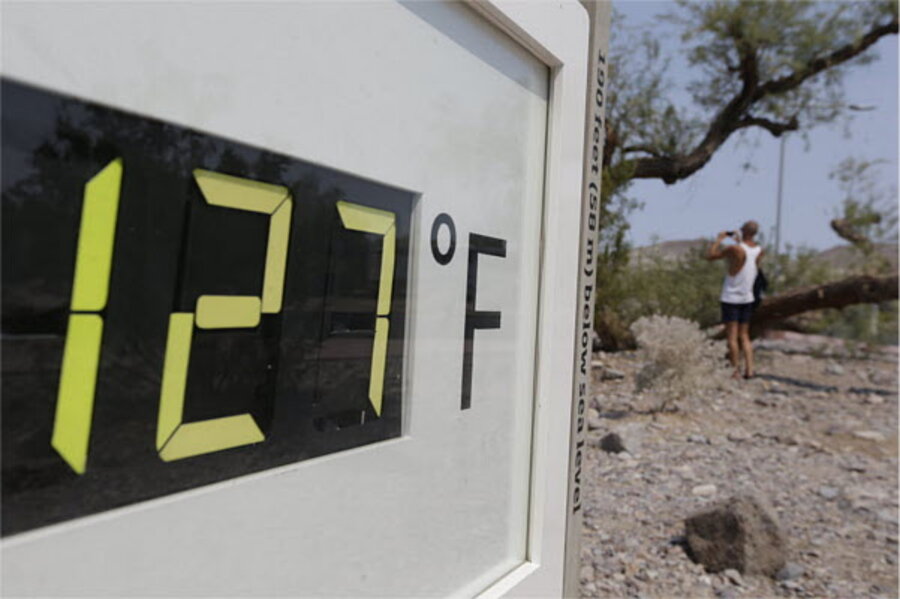Why running the AC in California's scorching valleys may get a bit cheaper
Loading...
| Los Angeles
People who live in the hot desert pay a higher rate for electricity than those who live by the cool ocean. Is that fair?
Dealing with an issue that has plagued utilities all over the country since the 1990s, California may be first out of the gate with a way to deal with rate fairness. The solution may also set a model that others will follow.
With the State Legislature’s bill AB 327 – which appears headed for passage and the signature of Gov. Jerry Brown – energy rates for those in hotter locales, who consume more power to run air conditioning, will be lowered to where they are more even with rates by the breezy seacoast, where the need for fans and air conditioners is less.
Ever since the electricity crisis of 10 years ago, marked by repeated blackouts and brownouts, utilities have designed rate structures to encourage conservation by raising the price per kilowatt hour for those in the highest consumption brackets. What’s more, rates in the lowest brackets have been frozen, even as utilities have had to raise their overall rates to compensate for their higher costs.
The result is a dramatic discrepancy in rates that homeowners pay in the two regions, where it is a normal occurrence that inland and desert valley homes, where more elderly and lower income Californians live, get socked with monthly electric bills of more than $500, while those in cooler coastal climes have bills under $100.
“This is a very big issue nationally and not just in California, so what you are seeing here now is likely to be exported and seen elsewhere,” says Barbara O’Connor, director emeritus of the Institute for the Study of Politics and Media at California State University, Sacramento. “There has been a big hue and cry in lots of states about regional disparities in winter and summer, and consumer pushback has resulted in this answer.”
The bill, which would hand back decisions on adjusting rates of privately-owned utilities to the California Public Utilities Commission (CPUC), has support from advocates for utility reform, consumers, the elderly, and low-income groups, as well as from utilities themselves.
“This takes the rate-making authority out of the Legislature and puts it back in the CPUC where it belongs,” says Mark Toney, executive director of the Utility Reform Network (TURN). “The CPUC is better because all parties get to present evidence and everyone can ask for data to back up claims that are heard, which puts the utilities and consumers on a level playing field. That’s not the case in the Legislature where the process is much more political, and frankly, they don’t have the expertise.”
But others don’t think the legislation is fair at all.
“This seems nothing short of criminal that those who live by the ocean are being penalized and having to subsidize those who live inland,” says Mandy Pereira, a mother of three, sipping a latte at a corner coffee shop in the affluent, San Fernando Valley neighborhood of Sherman Oaks. “Even though they’re handing rate decisions to a group which is not in the Legislature, this feels like government intrusion into our lives.”
Opponents also reportedly include the Sierra Club, manufacturers, and some farmers, for reasons ranging from fears of overall rate increases to concerns that new fees will act as disincentives for individuals and companies that have invested in solar power.
Southern California Edison, meanwhile, which serves 14 million people, is for the bill.
This “allows the CPUC to restructure how costs are recovered in rates, and provide relief to higher usage customers who have been bearing almost all cost increases in rates since the energy crisis of 2000-01," the utility wrote in a statement.
Besides pushback from consumers and stories of inequalities of paid rates trickling into newspapers, AB 327 was hastened by the announced closing of San Onofre Nuclear Plant nine years prior to its expiration date after it was closed for repairs.
“Removing a nuclear power plant from the grid is a major dislocation so they want to take a look at the rate structure and compensate for it,” O’Connor says of the utilities. She says they are also trying to come up with ways to encourage alternate sources of energy without penalizing utility companies that have been providing consistent energy reliably for years.
Responding to the concerns of environmental groups that the new bill will discourage renewable energy and drive consumers away from home rooftop leases for solar energy, Stephanie Chen of the Greenlining Institute, which advocates on behalf of low-income communities, said, “Nobody wants to see solar customers who have done the right thing for California’s environment get the rug pulled out from under them."
"But at the same time,” she is quoted as saying in a KPCC Radio online blog, “we want to make sure our system is both fair to people who have solar and people who don’t.”







